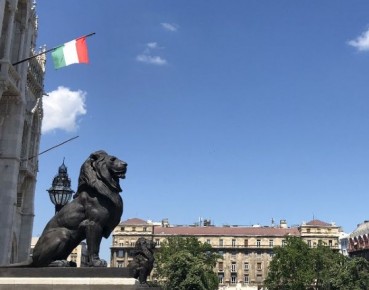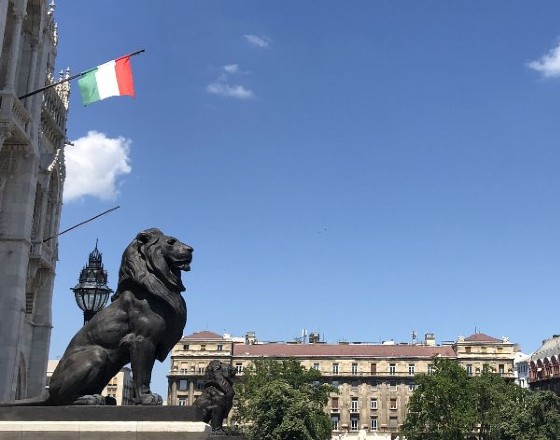
Budapest, Hungary (Maria Bninska, Public domain)
Prime yields are put at 5.25 per cent for office, 5.5 per cent for shopping center and high street retail, as well as hotel, with industrial at 7 per cent. New product coming to market further into 2020 may once again put downward pressure on office and hotel yields, the company said.
The office market has about 570,000 square meters (sqm) under construction, bringing the new supply expectation to 265,00 sqm for the year. However, development delays are likely to cause some of this pipeline to shift back.
The Hungarian OTP RE Fund acquired the Roosevelt office complex for a reported EUR150m at a yield of sub-5 per cent. Although office yields are estimated at 5.25 per cent, such trophy assets are transacting at lower yields.
No Vacancies
“Overall vacancy in the Budapest office market stands at 5.4 per cent, and at 3.2 per cent in the class ‘A’ sector. Low vacancy, high occupancy and possible rental increases make this a landlord favorable market,” said Anikó Kovács, head of office advisory and transaction services.
Industrial vacancy has reached a new low of less than 2 per cent, which effectively means that there is no vacancy for workable space in the market. “The industrial market capacity will be helped by the opening of new storage facilities with 180,000 sqm,” said Gábor Borbély, head of business development and research at CBRE Hungary. “The meaningful growth of new office market is good news for office and logistic property tenants: if everything goes according to plan, inaugurations will reach decade-long heights this year. It is somewhat overshadowed by the high rate of release spaces, though it is still favorable for companies who would like to move this year or the next,” he said.
David Johnston, head of advisory and transactions, added, “A bottleneck could be in the industrial market, where occupiers are far more sensitive to a EUR0.5-1 per sqm per month increase in rents. Developers such as CTP are building speculatively, but this is a drop in the ocean compared to what is needed in the market. Rising construction costs are a challenge with regard to the labor shortage.”
Budapest’s hotel accommodation capacity had increased by 1,600 rooms over the past three years; the likelihood this year is to see 2,150 rooms added in 18 new hotels in Budapest according to Laurent Lassier, head of hotel advisory.
There are 32 active hotel developments underway across the country with a total room capacity of 3,750 rooms by the end of 2022. However, delivery dates are slipping back in the current tight labor market. Occupancy in the Budapest hotel market has fallen slightly to 78 per cent, but the new market supply and the rates remain healthy.
The research Institute Hurun published data on ROI in real estate in cities around the world, with Budapest third in terms of profitability ratios of real estate investments. In 2019, the ratio amounted to 23.8 per cent. In second place was Hokkaido, Japan, with profitability of real estate investments at 24.8 per cent, and first place Saint Petersburg, Russia at 31.1 per cent.
Regional strength
A new peak in total transaction volumes of EUR13.9bn was reached last year across the Central and Southeast Europe (CSE). Including Austria and Serbia, the volume is even greater at EUR20.19bn. In Romania, transaction volumes surpassed the EUR1bn milestone and is the only main CSE market which has not seen significant yield compression.
Total investment volumes have doubled over the past 6 years within the extended CSE region that comprises Czech Republic, Hungary, Poland, Romania, Slovakia, Austria and Serbia.
Most countries within CSE reached new investment milestones: Poland has the largest share (38 per cent), followed by Austria (30 per cent) and the Czech Republic (15 per cent). Austria and Poland surpassed the EUR5bn level, reaching EUR5.98bn and EUR7.7bn respectively, while Romania, Hungary, and the Czech Republic all recorded volumes over EUR1bn (EUR1.06bn, EUR1.72bn and EUR2.98bn at the end of 2019).
Transactional activity was again dominated by the office sector accounting for 44 per cent of the total volume, followed at a considerable distance by the retail sector with 20 per cent and Industrial with 14 per cent. Hotels, Residential, Mixed-use projects, and Multi-use portfolios represented a combined 22 per cent. Over half of the total volume, 59 per cent, was transacted in the capital cities.
The main source of capital over the last six years was from Western Europe with an average share of 35 per cent, followed by local investors with a share of 28 per cent. Investors from other overseas destinations, including China, Russia, Australia and Canada, have deployed EUR14.27bn since 2014, representing a share of 16 percent. American investors claimed 11 per cent of the total volume, followed by South Africans, investors from CSE Countries, and Israeli investors with a combined share of 10 percent, according to the latest Real Estate Investment Market Outlook 2020 report on extended CEE region launched by CBRE this month.
“It’s the fourth year of growth in a row, with a new record transaction volume for the CSE core countries and an excellent performance for the extended region. In 2020 we expect to see a continued interest from investors for products across CSE markets, that will require a higher level of advisory and business acumen. CBRE expects COVID-19 is likely to have a negative short-term impact on certain sectors of the commercial real estate market in Europe, provided the outbreak is brought under control in a reasonable timeframe,” commented Anthony Selman, Head of Investment Properties CEE at CBRE.
After a strong year in the investment market, marked by continued appetite from local investors, Romania still has the highest prime office yield of the region, 7 per cent, remaining attractive for local and international capital. With 74 per cent of the total volume, the Romanian office sector dominates transactional activity, followed by retail with 16 per cent, while industrial, hotels and mixed-use projects claimed a combined share of 10 per cent.
“Romania is the only main CSE market, which has not seen significant yield compression. Since 2014, prime office yields have remained stable as have prime rents resulting in capital values that are now much lower than elsewhere offering investors great value for money,” stated Gijs Klomp, Head of Investment Properties, CBRE Romania
In 2019, Israeli investors were the most dominant with a record deal signed towards the year-end, representing 36 per cent of the total investment volume. Romanian investors were the second most active representing 23 per cent of total volumes and more active than the previous year, followed by South-Africans with a share of 17 per cent. Regional cities remained appealing to market players, almost doubling their contribution to the total investment volume comparing with 2018.
“Although the beginning of 2020 raises some concerns, we should still see a steady growth of investment volumes backed by strong growth in investor demand. Yield compression is expected to continue in the short run on the back of continuously low-interest rates (with the risk of stifled economic growth, central banks are likely to keep rates low in this environment) and some degree of convergence with other CSE markets notably Hungary. To put into the context, over the last 14 years, the first quarter accounted for 20 per cent of total annual investment per year, compared to the fourth quarter’s 30 per cent. Moreover, given that the investment market moves slowly in terms of transactions, any effect on investment may not be observable immediately. The current market turmoil is likely to add additional downward pressure on already low interest rates, which will further strengthen the case for real estate as an investment class. Therefore, we will likely continue to see high demand for investment property even if there may be practical implications for transactional activity in the near future,” said Gijs Klomp.
Hungarian green bonds
In February 2020, Hungarian Prime Minister Viktor Orbán announced the launch of the green bond that will be used to finance climate-friendly programs in the framework of a climate protection action plan unveiled at an annual state of the nation speech. So, Hungary is in talks on the issue of a three- to five-year “green bond” with investors in Japan and China, Finance Minister Mihály Varga said in an interview published on business news website mfor.hu. “We’re currently in talks on the green bond in two markets, in Japan and in China. There is stronger interest [in Japan] where a number of players have appeared as partners for an issue. We’ll launch this year; the framework will be established by mid-year on the basis of which we can decide the issue scale of such a security. We’re thinking of a three- to five-year maturity, and we’ll use the proceeds to finance investments that specifically protect the climate,” Mr. Varga told mfor.hu.


